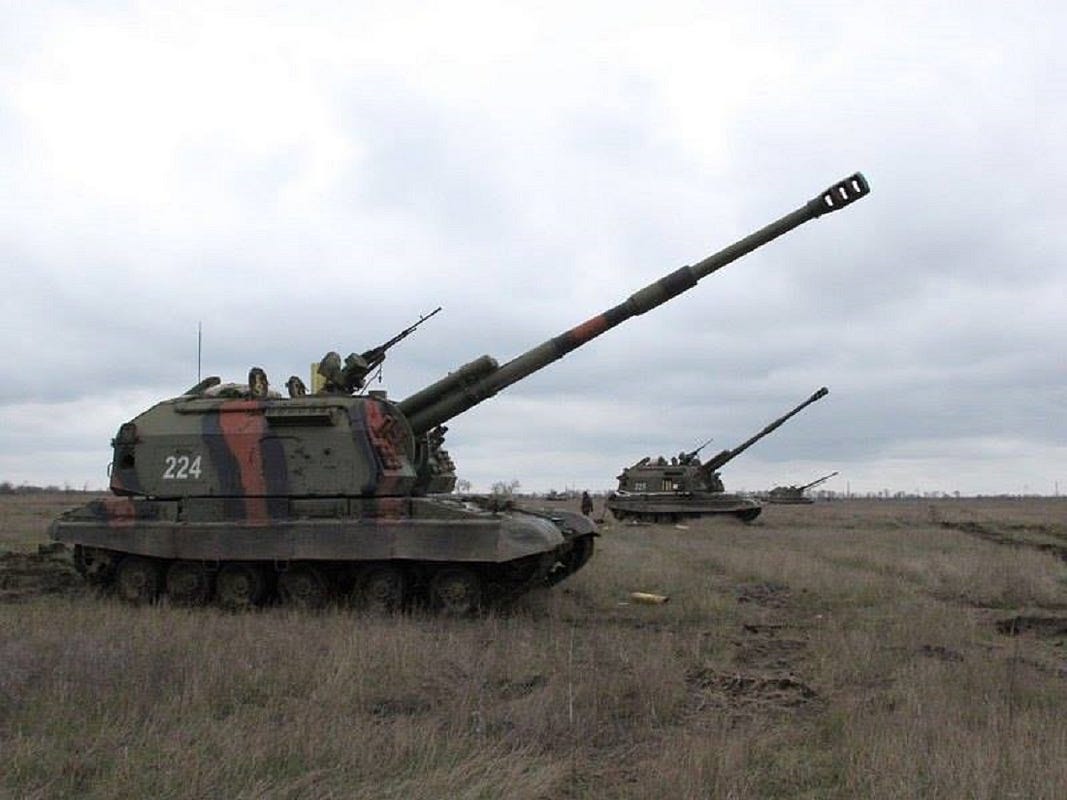Ukraine Separatists’ Weapon of Choice — Howitzers in Huge Amounts
Artillery battalion moves to Donetsk
As Russian-backed separatists in Ukraine dig in for a long war, they’re relying more and more on heavy artillery to match Kiev’s army.
Howitzers are nothing new to the conflict, and the drumbeat of artillery explosions has become part of eastern Ukraine’s ambient soundscape.
But within the past few days, the rebels have received a lot more of the big guns—and most likely from Russia.
Videos uploaded to social media showed one convoy near the town of Snizhne—near the Russian border—consisting of nearly 40 unmarked Kamaz military trucks hauling 18 towed artillery pieces. Owing to their size, ballistic shields and wheels, the guns resemble 2A65 Msta-B howitzers.
These 152-millimeter guns are some of the biggest in the Russian inventory, and have more than double the range of the separatists’ 122-millimeter D-30 guns.
The Associated Press spotted a similar convoy in Snizhne.
Several of the vehicles resemble support and radio trucks, because of their conspicuous shielded exteriors used to block electromagnetic interference.
The convoy included a single unarmed BTR-80—likely a command or forward observer vehicle for the artillery. This makes the convoy roughly the size of a Russian artillery battalion.
On the same day, monitors from Organization for Security and Cooperation in Europe witnessed the same convoy in Makeevka—on the road from Snizhne—headed west toward Donetsk. But the OSCE described the convoy as having smaller 122-millimeter guns, an OSCE spot report noted.
Either way, that’s a lot of guns, and just one of three convoys on the move in Ukraine on Nov. 8. The others included tanks—in a sign of even more heavy weapons pouring into the conflict.
The guns might give the separatists enough firepower to dislodge Ukrainian troops holding the strategic Donetsk Sergey Prokofiev International Airport just outside the city. If the rebels are trying to establish a breakaway state based in Donetsk, they need that airport.
Sunday morning marked some of the heaviest fighting in Ukraine in a month, with the worst centered around the airport, according to the Wall Street Journal. Ukrainian activists are also fearing a major offensive.
In his daily updates to Facebook, pro-Ukrainian activist Dmitry Tymchuk described separatist and Russian troops—regular army, airborne and military intelligence personnel—reorganizing into tactical assault groups.
There have been more probes of Ukrainian defenses, and Russian artillery crews appear to be refining their targeting skills.
 Above—Ukrainian self-propelled artillery in April 2014. Ukrainian Ministry of Defense photo. At top—pro-Russian artillery on Oct. 14, 2014. Dmitry Lovetsky/AP photo
Above—Ukrainian self-propelled artillery in April 2014. Ukrainian Ministry of Defense photo. At top—pro-Russian artillery on Oct. 14, 2014. Dmitry Lovetsky/AP photo
The National Security Defense Council of Ukraine recently dismissed the idea the separatists are ready for a major offensive—because there’s not enough separatists to overpower the Ukrainian defenders. That’s at least a ratio of three attackers for every one defender.
“I understand the reluctance of officials to fan a panic,” Tymchuk wrote on Nov. 8. “This is absolutely correct. But it’s still worth it to soberly assess the situation and make appropriate conclusions—assuming the best,preparing for the worst.”
There’s also practical reasons, borne out of military necessity, for the surge in heavy guns. Tymchuk’s dispatches note the two sides are fighting increasingly over fixed positions, with less of the maneuvering that characterized the opening months of the war. The separatists also don’t have air support.
Warplanes are too noticeable for this kind of war—at least for Russia.
The Kremlin has tried to construct a veneer of plausible deniabilitysurrounding its role in the conflict, relying instead on gunmen, unmarked tanks and other ground-based indirect fire weapons. This gives the separatists the ability to hit Ukrainian troops from beyond the defenders’ line of sight. And without implicating Russia.
To defeat Ukrainian aircraft, the separatists use shoulder-fired missiles, and previously used even more advanced weapons like the Buk missile launcher—which downed Malaysia Airlines Flight 17. The separatists also have drone-jamming technology.
On Nov. 3, an OSCE flew over the separatist-held town of Cermalyk when it encountered “military-grade GPS jamming,” the OSCE stated.
The OSCE aborted its drone mission. But whoever jammed it could have mistaken the drone for an artillery spotter. Ukrainian troops use a slew oftiny drones and R/C planes equipped with GoPro cameras to assist in artillery spotting.
Anything to give one’s side an edge—in the duel of the big guns.
No comments:
Post a Comment